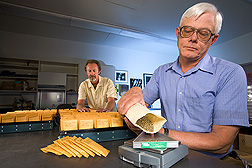This page has been archived and is being provided for reference purposes only. The page is no longer being updated, and therefore, links on the page may be invalid.
Village Wheats May Fend Off Stem Rust
By Marcia WoodNovember 27, 2007
Traditional wheats, grown by village farmers on the other side of the world, could hold genes that resist attack by stem rust. Killer races of that formidable fungal disease pose a threat to America's wheat, according to Agricultural Research Service (ARS) plant pathologist J. Michael Bonman.
As leader of the ARS Small Grains and Potato Germplasm Research Unit, Aberdeen, Idaho, Bonman directs a fast-paced, high-intensity search for wheats that could fend off rusts now emerging in east Africa. The team's focus is on the world's locally grown wheats, known to scientists as "landraces." These wheats typically are not as well-studied as those grown commercially on thousands of acres in the United States, for instance.
However, thanks to years of work by generations of plant explorers, breeders and others, seeds of 25,000 different kinds of local wheats are already at hand in a special collection at the Aberdeen research center. The collection, curated by ARS agronomist Harold E. Bockelman, serves as America’s official genebank of wheats gathered from around the planet.
To learn more about the rust resistance of the genebank’s landrace wheats, Bonman and colleagues combed decades-old records of the disease-fighting prowess of nearly 8,500 specimens. Plant pathologist Don V. McVey, now retired from the ARS Cereal Disease Laboratory, St. Paul, Minn., created those records when he tested the plants, beginning in 1988.
Though McVey couldn’t have exposed the plants to the new wheat stem rusts now damaging wheatfields of east Africa, his test results are nonetheless still relevant today, according to Bonman.
The new analyses of McVey’s findings revealed notable resistance in wheats from, among other places, Chile, Ethiopia, Turkey, and Bosnia and Herzegovina. The scientists are now intensifying their analyses of other genebank landraces from these areas—not just those that McVey studied. And, they're using the findings to choose specimens to send to Kenya and Ethiopia, for testing in the heart of the rust epidemic.
Read more about the research in the November/December 2007 issue of Agricultural Research magazine.
ARS is the U.S. Department of Agriculture's chief scientific research agency.

